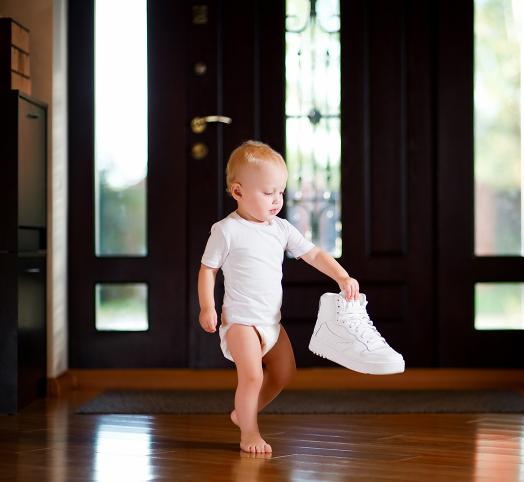First steps, first shoes
Updated on March 22, 2023
Created on July 24, 2019
Find your nearest point of sale here
Updated on March 22, 2023
Created on July 24, 2019

When the time comes to buying your baby their first pair of shoes, how do you find the right pair among the dozens of models on show in shop windows? The best thing is not to go for the most aesthetic pair, but to pay particular attention to a few key points!
For the first few months, your baby will not need shoes: direct contact with the floor – barefoot, in socks or soft leather booties – will help them develop the muscles in their little feet, as well as their sense of balance more easily.
But when they start to stand up and take their first steps (between 9 and 18 months, depending on the child), it will be time to get their first pair of real shoes! It's important to make the right choice – for your baby's comfort, as well as the development of their feet.
First shoes: hard or soft? When your baby takes their first steps, they are slightly bow-legged and their feet are still naturally flat. It was long believed that in order to help the arches of their feet to develop and their legs to straighten out, babies' shoes had to have heel stiffeners and pronounced arches. Most of the models on sale nowadays are still like this.
But for a few years now, podiatry research has demonstrated that babies' feet develop most effectively when they have nothing on them. So the ideal shoe would provide them with direct contact with the ground, giving them better balance and helping their muscles and arches to develop completely naturally. But obviously your child should not go running around barefoot outside.
For their comfort, to stop them from slipping and to protect their feet, a number of brands now offer soft leather or canvas shoes that allow the skin to breathe with light and supple soles. Whenever possible, choose shoes with Velcro fasteners.
This way, they will fit the morphology of your child's feet perfectly and they will have no trouble putting them on and taking them off. The right size It's sometimes tempting to choose shoes that are a little too big so that they last longer. A big mistake! In addition to being uncomfortable, shoes that are too big will also run the risk of interfering with your child's still precarious balance.
Your footwear specialist will certainly be able to accurately measure your child's feet. Moving up a size Babies have chubby feet that are not terribly sensitive. Your child probably won't even realize it when their shoes are too small.
It's up to you to check regularly by pressing down on the front of the shoe when they are standing up: there should be a good centimeter between their toes and the tip of the shoe.
Remember that until they are three years old, they will need new shoes about every four months: they'll end up with quite an extensive collection of them!